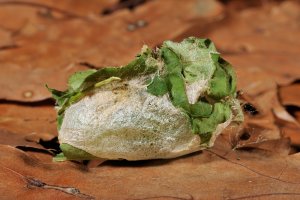The Most Beneficial Gardener Is a Lazy One!
April 3, 2024
By: Alexis Olechowski, Park Interpreter
As we gaze upon our frost-kissed gardens, tradition nudges us toward a fall cleanup and a “clean slate” come spring. But fret not, for here’s your official approval to postpone! From leaf-raking to perennial pruning, if the prospect of autumn chores seems overwhelming, rejoice. The transformation of garden practices to prioritize the well-being of insects and ecosystems not only promotes environmental sustainability but also surprisingly demands less effort in the long run. Embracing nature-centric approaches, like leaving fallen leaves, stalks, and stems in place, allows gardeners to cultivate a self-sustaining ecosystem. This minimizes the need for excessive maintenance. Bask in the tranquility amid dormant shrubs, knowing you’re providing snug winter retreats for native pollinators. If you’re not yet convinced of the benefits of reduced lawn care, there’s more. As spring’s vibrant colors awaken Michigan landscapes, the age-old temptation to tidy up persists. Yet again, postpone! Traditional gardening often falls short in providing sufficient resources for pollinators and wildlife. Understanding the pivotal role of leaving stalks and stems into late spring has taken root. Delving further into sustainable gardening practices, initiatives like “Leave the Leaves” stand out as influential tools for nurturing Michigan’s delicate ecosystems. Just how significant are the impacts from these small changes in our clean up practices? Let me explain.
Leaves as habitat
Fallen leaves on the ground create microhabitats for insects and small creatures, sustaining a vibrant ecosystem. The decaying plant material, left undisturbed, transforms into a valuable source of nutrients, enriching the soil. Allowing fallen leaves to linger serves as natural mulch, shielding the soil from erosion and moisture loss. As leaves decompose, they contribute organic matter, enhancing fertility and structure, vital for supporting a diverse range of plants, fostering a healthier and more resilient ecosystem. Yet, before these leaves become nutrients in the soil and food for your plants, they play a crucial role for our pollinators. Many butterfly and moth species overwinter as pupae or larvae in this leaf litter, and disrupting this natural cycle by clearing away leaves, stalks, and stems interferes with their life cycles. This underscores the significance of “Leave the Leaves” initiatives. Allowing these natural materials to remain undisturbed provides a haven for these insects to overwinter, ensuring the continuation of their lifecycles and supporting the broader ecosystem. In turn, these insects become integral components of the food web, sustaining larger species like birds and mammals. While these changes are small, we must acknowledge the significance of these initiatives in fostering a harmonious coexistence between nature and our backyards.

Leaving stalks and stems over the winter season serves as a sanctuary for beneficial insects, welcoming ladybugs, lacewings, beetles, butterflies, small mammals, and birds, thus fostering a diverse habitat. As these structures break down, they release organic matter crucial for maintaining soil health and supporting new vegetation growth. Yet, before these remnants become worm food or nesting material for birds, they play a pivotal role for solitary bees, a vital component of Michigan ecosystems. Unlike honeybees, solitary bees like mason and leafcutter bees are non-aggressive and do not form colonies. They seek hollow stems, reeds, or cavities to build nests, carefully provisioning them with eggs, pollen, and nectar. The closed ends of these stems provide protection and insulation for developing bee larvae. By leaving stalks and stems undisturbed in our gardens, we create essential habitats for solitary bees, supporting their reproductive cycles and contributing to local ecosystem health. However, it’s crucial to note that preserving this life cycle requires leaving stalks and stems untouched until warm weather allows the bees to emerge. Our efforts to preserve pollinators must encompass enhancing their success at every stage of their life cycle. These small clean up practices, changing when and how we clean our gardens, have massive impacts on these pollinator communities and their ability to thrive.
Hitting pause in the spring to support wildlife
The practice of preserving stalks and stems in Michigan gardens during spring emerges as a simple yet impactful way to support local ecosystems. Leaving stems, stalks, leaves and other natural debris until nighttime temperatures have been consistently in the 50s allows for overwintering insects to emerge. This approach creates a sanctuary for beneficial insects, offers essential nesting sites for solitary bees, enhances biodiversity, and contributes to nutrient cycling. As stewards of the environment, let us embrace the beauty of nature’s cycle and recognize the value of every element in the intricate web of life surrounding us. Initiatives like “Leave the Leaves” underscores how small changes in our gardening and landscaping practices can have profound positive effects on Michigan’s ecosystems. By adopting these approaches, we actively contribute to biodiversity, nurture soil health, and provide vital habitats for pollinators and other wildlife. Consider the compelling advantages these practices offer to the ecosystems we inhabit, and if that alone isn’t enough to convince you, keep in mind that many of these environmentally friendly approaches also translate into a reduced workload for you. Moreover, the beauty lies in their adaptability, allowing you to incorporate them seamlessly into your gardening routine based on your preferences and capacity. These practices empower you to make a positive impact on the environment without compromising on convenience or flexibility. To streamline the concept of a sustainable and eco-friendly year of yard work, here’s a simplified list to underscore the crucial cleanup steps to bear in mind as you tend to your garden this year as well as several ecology garden resources to learn more.

Quick gardening tips to keep in mind:
- Cultivate a vibrant ecosystem in your yard by incorporating native plants.
- Increase pollinator benefits in your garden by preserving stalks and stems throughout the winter months.
- Leaving 18-24” of stalk when pruning dead flowers, creating ideal nesting sites during warmer seasons.
- Practice mindful gardening by waiting for pollinators to emerge before removing stalks and stems in the spring.
- Opt to rake or blow leaves instead of shredding them with a lawnmower.
- Pile leaves under trees or in garden beds if you choose to clear your lawn of leaf litter.
- Avoid the use of chemicals and fertilizers in your gardening practices.
Links for more Information:
- https://www.canr.msu.edu/home_gardening/pollinators/
- https://xerces.org/blog/dont-spring-into-garden-cleanup-too-soon
- https://xerces.org/pollinator-resource-center/great-lakes
- https://extension.psu.edu/programs/master-gardener/counties/lackawanna/news/how-to-support-our-pollinators-insects-and-birds-during-the-winter-months
- https://www.gardencityharvest.org/the-real-dirt-garden-city-harvest-blog/2022/9/30/native-pollinators-creating-year-round-habitat-in-your-yards-and-gardens-gbbyd
- https://www.xerces.org/sites/default/files/publications/18-014.pdf
- https://homegrownnationalpark.org/
- https://www.michiganaudubon.org/fall-garden-clean-up-dos-and-donts/
